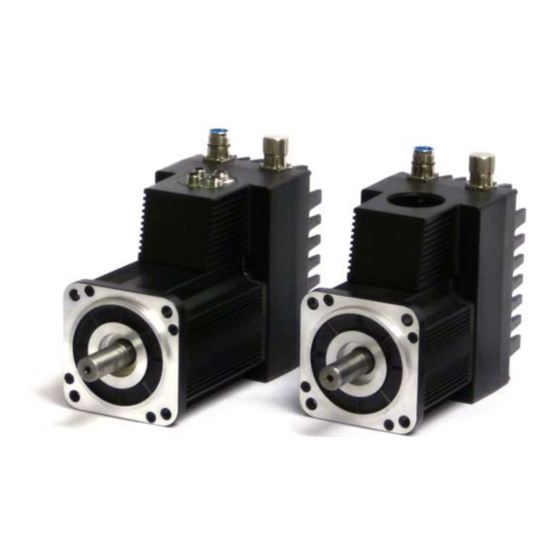
Summarization of Contents
1 Introduction
1.1 Features
Outlines key advantages and features of the MAC series servo motors, including cost-effectiveness, performance, and expandability.
1.2 Overall description
Presents a block diagram of the MAC motor's internal components and provides a general overview of its architecture and functionality.
1.3 Expansion modules overview
Introduces the various expansion modules that can be mounted internally to adapt the MAC motor for diverse applications.
2 Function description
2.1 Using Position mode
Guides users on setting up the MAC motor in Position mode using MacTalk software for initial configuration and normal operation.
2.2 Gear Mode
Explains the Gear mode, enabling motor movement synchronization with external pulse signals and gear ratio adjustments.
2.6 Mechanical Homing
Details the five different mechanical Homing modes for finding the motor's zero position after power-up or during operation.
2.7 Error messages and error handling
Lists fundamental parameters for protection, explains error messages, and provides guidance on error handling and recovery.
3 Hardware description
3.1 Connector overview
Provides an overview of the connectors on the basic MAC motors, detailing RS232, User I/O, and Power Supply interfaces.
3.2 Power Supply
Covers power supply requirements, including voltage ranges, grounding, and dimensioning of power supplies and fuses for different MAC motor series.
3.3 Serial interface
Explains the asynchronous serial interface (RS232/RS485) for controller communication, covering signal levels and connection methods.
3.4 User I/O
Details the analogue and digital inputs, status outputs, and multifunction I/O capabilities of the MAC motor.
4 MacTalk setup software
4.1 Installation of MacTalk
Guides on obtaining the latest MacTalk version and performing the installation process.
4.2 Using MacTalk to setup the motor
Introduces MacTalk as the primary software for motor setup, covering features like operating mode selection, parameter adjustment, and monitoring.
4.3 MacTalk Scope usage
Explains how to use the MacTalk Scope function for testing applications and diagnosing system errors with its oscilloscope features.
5 Expansion Modules
5.1 Expansion Module MAC00-CS
Introduces the MAC00-CS module, a basic expansion plate providing power and I/O connections with IP67 rating.
5.2 Expansion Module MAC00-B1/B2/B4
Details the MAC00-B1, B2, and B4 modules offering industrial interfaces (DSUB, Cable glands, M12) and enhanced features like RS232/RS485 support.
5.3 Expansion module MAC00-B41
Describes the MAC00-B41 module with M12 connectors and optical isolation for RS232, RS485, and USB communication.
5.4 Expansion module MAC00-B42
Introduces the MAC00-B42 module, functioning as a small PLC with 12 I/O terminals for user programs and various digital/analogue capabilities.
5.6 Expansion Mod. MAC00-FC2/FC4/FC41
Covers CANopen® expansion modules (FC2, FC4, FC41) for connecting MAC motors to a CANopen® network, detailing configuration and communication.
5.7 Expansion Module MAC00-FD4
Explains the MAC00-FD4 module for DeviceNet connectivity, including baud rate, node-ID setup, and IO-message structure.
5.8 Expansion Module MAC00-FP2/FP4
Details the MAC00-FP2 and FP4 Profibus-DP slave modules, supporting high-speed communication and various input/output configurations.
5.9 Expansion Module MAC00-FS1/FS4
Introduces the MAC00-FS1 and FS4 modules for high-speed RS485 communication in multi-axis systems, including connector descriptions.
5.10 Expansion module MAC00-P4/P5
Describes the MAC00-P4 and P5 modules for analogue 4-20mA interface control and master/slave configurations, detailing connectors and setup.
5.11 Expansion Module MAC00-R1/R3/R4
Details the MAC00-R1, R3, R4 expansion modules, acting as small PLCs, covering graphic programming, firmware setup, and command references.
6 Appendix
6.1 Technical Data
Provides detailed technical specifications for MAC motors MAC050 to MAC4500, covering controller capacity, speed, torque, and protection.
6.6 Installation instructions
Offers step-by-step guidance on mounting gears or brakes correctly, emphasizing torque specifications and precautions.
6.7 Emergency stop considerations
Discusses essential emergency stop considerations and requirements based on European directives and safety standards.
6.8 Trouble-shooting guide
Addresses common motor issues related to communication, setup, and mechanical behavior, providing troubleshooting actions.
6.10 Serial communication
Details serial communication operations, including changing baud rates, managing registers, and performing resets via serial or fieldbus interfaces.
6.11 MacTalk communication
Guides on using MacTalk for motor control via serial links, covering register access, writing, and reading operations.
6.12 Registers
Lists and describes internal registers for MAC motors MAC50-141 and MAC400-4500, explaining their functions and access methods.
6.13 Connecting to other equipment
Provides examples and instructions for connecting MAC motors to external equipment like Jetter PLCs using various modules and cables.
6.14 Accessories
Lists available accessories for MAC motors, including cables, connectors, power supplies, and brakes.
6.17 CE Declaration of Conformity
Contains the EU Declaration of Conformity, stating the manufacturer and product compliance with electromagnetic compatibility and low-voltage directives.
6.18 UL Certificate of Compliance
Includes the UL Certificate of Compliance, confirming that representative samples of POWER CONVERSION EQUIPMENT meet UL standards.
7 Practical Applications
7.1 Synchronous Movement
Explains synchronous movement using master/slave configurations, particularly in Gear mode with expansion modules.







Need help?
Do you have a question about the MAC402 and is the answer not in the manual?
Questions and answers